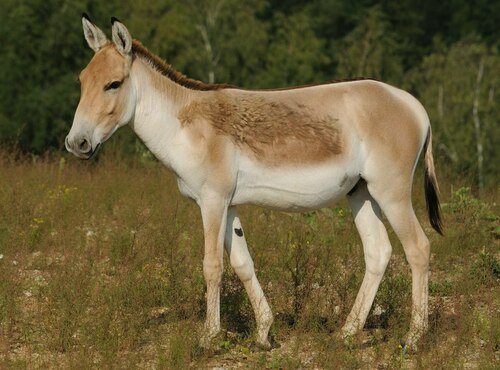
Onager
The Asiatic wild ass, or onager, thrives in Central Asia's dry terrains. Known for its swift speed, it sports a sandy coat with a unique dorsal stripe. This resilient grazer helps sustain grassland ecosystems, showcasing adaptability and ecological importance in its harsh habitat.
199.58 - 290.3 kg
Weight
Length: 2.10312 - 2.49936 m; Height: 1.49352 m
Size
Brown, Grey, Yellow, Red, White, Multi-colored
Color
2 years
Age of Sexual Maturity
Low
Aggression
70 mph
Top Speed
Near Threatened
Conservation Status
Stable
Population Trend
Characteristics
Equus hemionus, commonly known as the Asiatic wild ass or onager, inhabits arid and semi-arid regions across Central Asia. Notable for its speed and agility, this equid features a sandy coat and a distinctive dark stripe along its back. It plays a crucial role in ecosystem dynamics by grazing on sparse vegetation, which helps maintain the balance of the grassland habitat.
Distribution Range of the Onager
Equus hemionus, commonly known as the Asiatic wild ass or onager, is native to central and western Asia. Its geographical distribution includes countries such as Mongolia, Kazakhstan, Iran, India, and parts of China. Historically, it was found across a much wider range, including parts of the Middle East and the Arabian Peninsula.
Onager's Habitat
Environmental Conditions
Equus hemionus typically inhabits arid and semi-arid regions. These areas are characterized by sparse vegetation, such as desert steppes and semi-desert environments. The climate in these regions is usually harsh, with extreme temperatures ranging from very hot in the summer to cold in the winter, and low annual rainfall.
Ecological Niche
The Asiatic wild ass is well-adapted to these dry environments, where it primarily feeds on grasses, shrubs, and other available vegetation. It is a highly mobile species, capable of traveling long distances in search of food and water. This mobility is essential for survival in its harsh habitat, where resources can be scarce and widely dispersed.
Copyright @ Nature Style Limited. All Rights Reserved.
 English
English